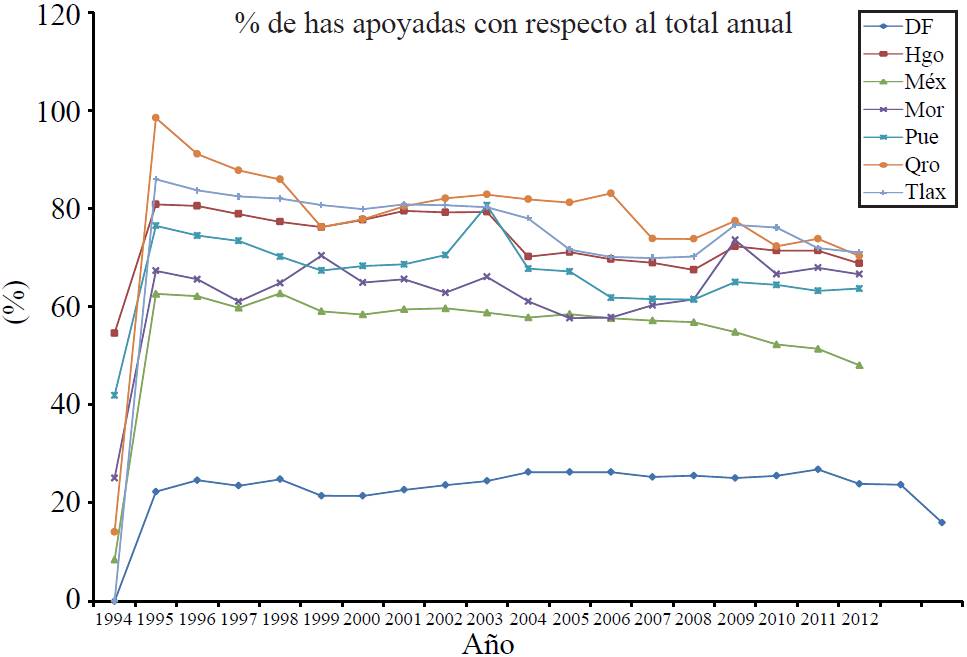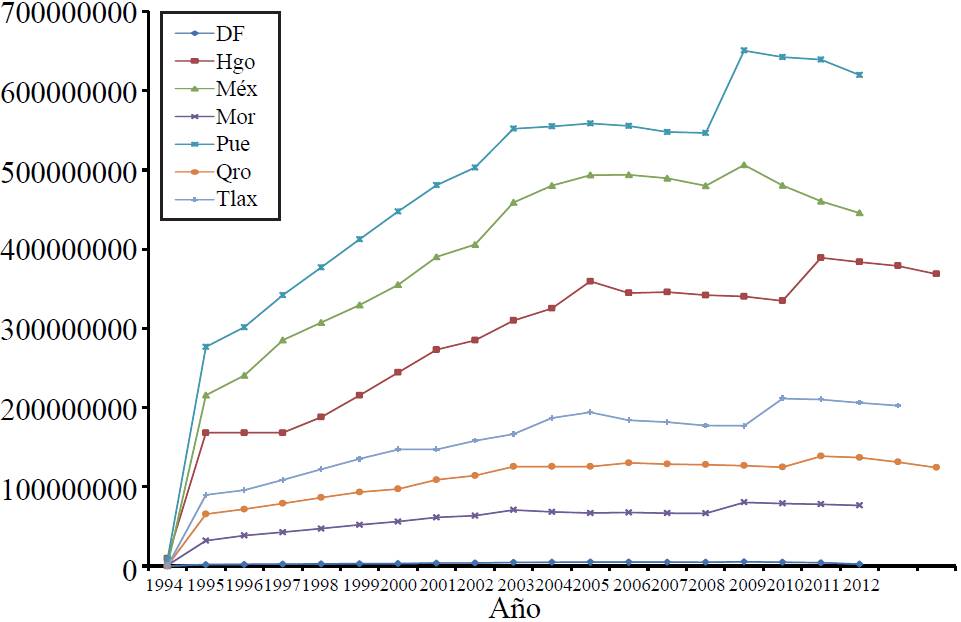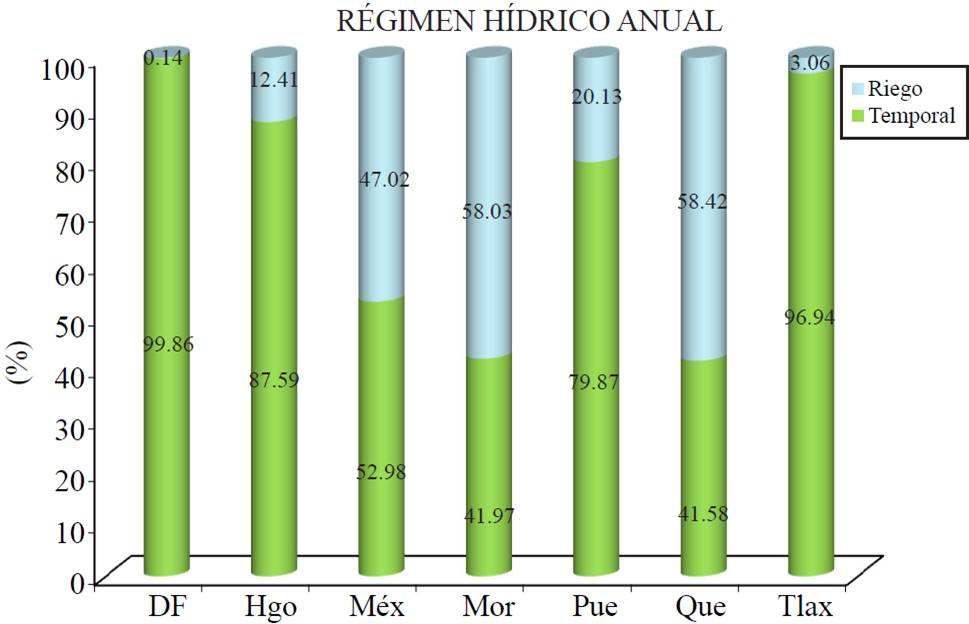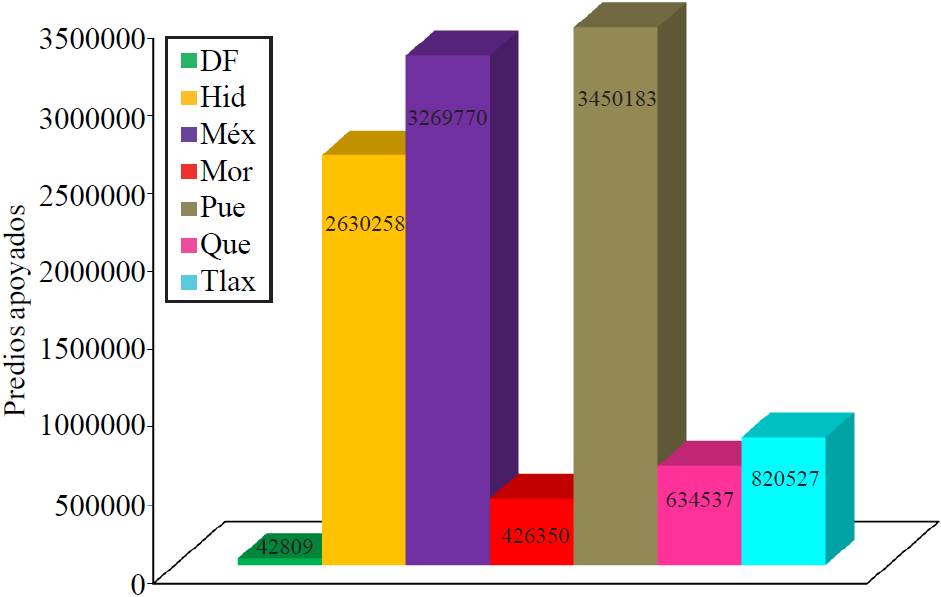Serviços Personalizados
Journal
Artigo
Indicadores
-
 Citado por SciELO
Citado por SciELO -
 Acessos
Acessos
Links relacionados
-
 Similares em
SciELO
Similares em
SciELO
Compartilhar
Revista mexicana de ciencias agrícolas
versão impressa ISSN 2007-0934
Rev. Mex. Cienc. Agríc vol.7 no.1 Texcoco Jan./Fev. 2016
Articles
Public policy for rural areas: PROCAMPO in the central region of Mexico
1Colegio de Postgraduados- Campus Montecillo. Carretera México-Texcoco km 36.5, Montecillo, Texcoco, Estado de México. C. P. 56230. (tms@colpos.mx; mercedes@colpos.mx; jlgcue@colpos.mx).
The State designs and implements the necessary public policies in order to support the primary sector. PROCAMPO has emerged as the answer to the situation in rural areas (1993), which can be surmised as an environment of poverty, loss of self-sufficiency, migration, fall in productivity and new rurality. This context has an important influence on the creation of public policy meant to support agricultural production. PROCAMPO was the Mexican agricultural policy during 20 years of operation; it was the main tool for agricultural policy given that it was the program that received the largest budget.
Keywords: income; program; rural development; State; surface area
El Estado diseña e implementa las políticas públicas necesarias para el apoyo al sector primario. PROCAMPO surge como respuesta a la situación de la época (1993) en el medio rural, que se puede resumir en un entorno de pobreza, pérdida de autoabasto, migración, caída de productividad y la nueva ruralidad, este contexto influye de manera importante para la creación de una política pública destinada a apoyar la producción agrícola. La política agrícola mexicana durante 20 años de operación fue PROCAMPO, ya que fue la principal herramienta de política agrícola, porque fue el programa al que se le asigno mayor presupuesto.
Palabras clave: desarrollo rural; Estado; ingreso; programa; superficie
Introduction
Public policies are government actions with objectives of public interest that emerge from a diagnostic process and feasibility analysis, taking into account peoples’ interests and needs with the objective of effectively addressing the specific public problems (Franco, 2012).
Public policies are directed towards public interest or benefits and the capacity to fulfill them; peoples’ involvement in conjunction with the government is indispensable in defining the objectives and course of actions for policy. What distinguishes public policies from other government actions is the need for a consensus between social players in order to make decisions on actions regarding public goods and services: education, health, production, farming, sustainable management of natural resources, migration, among others.
The Mexican State has been present in rural areas practically since its foundation; agricultural reform and the economic changes in rural areas are examples of this.
Public polices in Mexico have followed the neoliberal development action model since the end of the XX century. The Mexican State has taken actions such as the Planes Nacionales de Desarrollo that have initiated the government proposal of each public administration since 1932. Nowadays, the Plan Nacional de Desarrollo remains in effect (2012-2018).
The agricultural policy is a sector that has been lurching since various presidential terms ago. Until now, a policy that transcends a six-year presidential term has not yet been defined.
A notable and significant action was carried out in recent years with PROCAMPO, a response program to the changes derived from the NAFTA. With time, this permitted the creation of a specific policy although it was not expressed in a clear and defined manner from the start; rather, it was organized over the course of time.
Since its creation, PROCAMPO was one of the main sectorial public policy tools due to its budgetary assignations and until 2013 (its last year in operation), it was the federal program with the largest addressed rural population.
In this work, the program operation was researched in the following states: Estado de México, Morelos, Hidalgo, Puebla, Querétaro, Tlaxcala, and Distrito Federal. In general, PROCAMPO was a federal program well accepted by rural producers.
PROCAMPO lasted 20 years, from 1993 to 2013, and provided a significant quantity of data and information that allowed for the analysis of these elements and to be able to reach determined social, political, and economic conclusions of what the State has done in Mexican rural areas.
The Mexican State created the development project PROCAMPO for poor rural areas and its objective was to solve the agro-food problems. Even though the program was focused on these social sectors, with the passing of time it also meant a significant aid for small and medium agro-livestock companies.
History
The PROCAMPO program emerged as the answer to a situation at the time in rural areas, which can be surmised as an environment of poverty, loss of self-sufficiency, migration, fall in productivity and new rurality. This context had an important influence on the creation of a new public policy destined to aid agricultural production and formed a fundamental part of the emergence of PROCAMPO.
The Programa de Apoyos Directos al Campo was implemented at the end of 1993 and emerged as a mechanism for the transfer of resources in order to compensate the national producers through the subsidies that their foreign competitors received, substituting the price guarantee framework of grains and oilseeds. It provided aid per hectare or fraction registered in the PROCAMPO directory or territory that was sown with any licit cultivation or that was under an ecological project authorized by the Secretaría de Medio Ambiente y Recursos Naturales.
It was a program that emerged from what was once known as the Secretaría de Agricultura y Recursos Hidraúlicos (SAHR). At that time, the Apoyos y Servicios a la Comercialización Agropecuaria (ASERCA) also emerged, and it was in this organism where the administrative and operational procedures of PROCAMPO were carried out. Although due to the size of the program, it practically operated independently of any organism. From the Secretary, the program then proceeded to state delegations where it was distributed between the Distritos de Desarrollo Rural (DRD) and finally operated from the Centros de Apoyo al Desarrollo Rural (CADER).
PROCAMPO substituted the previous systems based on price guarantees.
PROCAMPO was regulated by the decree published in the Diario Oficial de la Federación on July 25, 1994, and its erratum on September 26, 1994 (ASERCA, 2013).
Since its appearance, PROCAMPO has been one of the main sectorial public policy tools due to its budget and until 2013 (before its disappearance), it was the federal program with the largest rural population served.
The operation was performed based on a group of rules that were established in the decree previously mentioned, which were compulsory and constituted the basis so that the subsidy grants would be transparent. Notable among these rules were that: a) those producers who were in legal possession and usufruct of the plots for which surface eligibility had been demonstrated, independent of their quality as owners or lessees, received aid; and, b) the benefit applied only for eligible surfaces that must be sown, where livestock or forestry was exploited, or was under an ecological project.
The aid was granted to the producers who proved they were the proprietors or owners in good faith or in derived possession (on lease, usufruct, or partnership) of plots with eligible surfaces in exploitation of that mentioned in PROCAMPO. Surface eligibility was a characteristic of a plot that was not transferable, but in the case that rights were transferred, the new owner would also acquire the PROCAMPO benefits. Therefore, the eligible surface was strictly delimited, and thus the center of attention of the program was closed to the incorporation of new surfaces.
PROCAMPO included the country’s producers that voluntarily registered themselves in the directory, independent of the size of the plot, tendency type of the soil, water regime, production method or political affiliation.
The nine eligible crops for PROCAMPO were: cotton, rice, safflower, barley, beans, maize, sorghum, soy and wheat. Initially, in order to receive the aid, it was a requirement to sow one of these crops; however, beginning in the agricultural cycle of spring-summer 1995, it was allowed to sow any licit crop, with the purpose of diversifying the agricultural activity and foster a greater autonomy in the planting decisions of the producers.
At the end of 2013, the federal government announced that PROCAMPO would be restructured and would change its name to PROAGRO Productivo. With this, the operating rules, the aid granted, the means of operation, etc., would change. In short, the program as such disappeared (El Financiero, 2014).
In this study, a series of data are analyzed allowing to conclude that there had been farmer-state relations and that this specific relation derived from PROCAMPO created certain social, economic, and political characteristics that are worthwhile to define.
Method
If the Mexican State intervenes in rural areas in a correct manner by means of PROCAMPO, it then generates development. The methodology to follow in order to prove this hypothesis is through the analysis of objectives, results, components and its primary changes. We should then be able to know if PROCAMPO made this aid accessible to low income producers that could not benefit from the price guarantee policy.
With this analysis we can visualize the results and compare them to the initial hypothesis and objectives; this comparison allows us to make a 20-year evaluation of the public policy from a case study point of view. The INEGI considers the central region to be comprised of the states of Morelos, Tlaxcala, Puebla, Hidalgo, and Querétaro, and in addition this study includes the Distrito Federal and Estado de México due to these being entities of great importance in the center of the country. In the states of Hidalgo, Morelos, Puebla, Querétaro, Tlaxcala, Estado de México and Distrito Federal, there is much diversity in the economic, political, social and environmental factors. In Table 1, a summary of a few of the states’ characteristics can be found:
Table 1. State comparison.
| Estado | Superficie (km 2 ) | Clima | Orografía | Población (2010) |
|---|---|---|---|---|
| D. F. | 1 485.49 | Templado subhúmedo | Sierras y valles | 8 851 080 hab. |
| Hidalgo | 20 846.45 | Seco, semiseco y templado subhúmedo | Sierras, valles y llanuras | 2 665 018 hab. |
| México | 22 356.80 | Templado subhúmedo | Montañas y valles | 15 175 862 |
| Morelos | 4 892.73 | Cálido subhúmedo | Sierras, valles, llanuras, lomas y meseta | 1 777 227 |
| Puebla | 34 289.66 | Templado subhúmedo y cálido subhúmedo | Sierras, llanuras y lomas | 5 779 829 |
| Querétaro | 11 683.80 | Seco y semiseco | Sierras, llanuras y meseta | 1 827 937 |
| Tlaxcala | 3 991.14 | Templado subhúmedo | Llanuras, lomas y sierras. | 1 169 936 |
In order to test the utility of the program, a compilation of the data available was utilized, reviewing previous evaluations and creating statistical models. The means for the data compilation were various databases. The analysis was carried out as follows, starting from the review. The procedure for the analysis is described below.
There is an original database denominated registration of beneficiaries for each state and for each cycle (fall-winter and spring-summer) with 21 fields; in total 128 databases were reviewed. The data obtained for the Distrito Federal and Tlaxcala were reduced to the spring-summer cycle.
The following fields were chosen in order to carry out the data analysis with the SPSS program: supported surface area, amount of support, crops, water regime and program. The following data was obtained per state, year and cycle: average, minimum, maximum, sum of cycles, standard deviation and variation coefficient of the supported surface area; and average, minimum, maximum, sum of cycles, standard deviation and variation coefficient of the amount of support ($); the three main crops and their percentages; and the quantity of seasonal and irrigation beneficiaries. The information not found in the databases was inferred by means of regression (linear and non-linear) and prediction. The total hectares supported were summed together (per state, cycle, and year).
The total sown hectares (per state, cycle, and year) were consulted on the Sistema de Información Agroalimentaria de Consulta (SIACON) in order to obtain the percentage resulting from the sown hectares with the supported hectares. The total supported amount was added (per state, cycle, and year). The three most frequent crops per state (frequencies of 19 years) per cycle were considered. For the water regime, the watering and seasonal percentages were obtained.
Results
In the central region of the country in the case of PROCAMPO, it is worth mentioning that in the entities of Distrito Federal and Tlaxcala, support is only given during the spring-summer cycle, and thus great variations will be seen between these two states and the other five studied in regards to totals and percentages.
Regarding the supported surface area, it can be concluded that according to SIACON, the cultivated surface area in the seven states studied corresponds to a total of 46,664,933.80 hectares for the 18 years analyzed, and the supported surface area for the program is a total of 31,344,817.40, which corresponds to 67.17% of the total support with regard to the total area sown; these behaviors can be observed by state in Graph 1. Here, it can be observed that the Distrito Federal received the lowest percentage of support, which can be due to the fact that the Distrito Federal is not characterized as having agriculture as a primary economic activity. One can also see in the graph that the Estado de México, although it is one of the states with a great number of beneficiaries and with a large surface area, is not represented when comparing the support as a percentage with other states with less supported populations and less cultivated surface areas.

Figure 1. Percentage of hectares supported by PROCAMPO with regard to the yearly total of the period from 1994 to 2012.
The average yearly supported percentage with regard to the total area sown from 1994 to 2012 by state is as follows: Distrito Federal (23.80%), Hidalgo (66.32%), Mexico (31.81%), Morelos (50.38%), Puebla (53.14%), Querétaro (67.76%), and Tlaxcala (77.35%), thus one can observe that Tlaxcala was the state with the greatest percentage of support and that the Distrito Federal received the least. It is also important to consider that with regard to the cycles, there was more support during the spring-summer cycle.
Regarding the yearly amount in monetary terms of the support provided by the program, the total from 1994 to 2012 was $28 116 843 604 for the seven states, corresponding on average to: Distrito Federal $73 727 362.10 (0.27%), Hidalgo $5 609 380 878 (31.94%), Estado de México $7 320 615 741 (14.03%), Morelos $1 119 451 666 (5.91%), Puebla $9 018 648 561 (34.19%), Querétaro $2 016 338 464 (8.38%), and Tlaxcala $2 958 722 932 (10.82%). It can be observed in Graph 2 that the Distrito Federal benefited the least with regard to the other states, and that Puebla received the most support, with the Estado de México and Hidalgo being two of the states with the largest number of beneficiaries.
Regarding the main crops supported from 1994 to 2012, it is understood that in the majority of the states maize is the main crop with the following frequencies (taking into consideration the 18 years analyzed): Distrito Federal 17 (only spring-summer cycle), Hidalgo 36, Estado de México 34, Morelos 17, Puebla 33, Querétaro 17, and Tlaxcala 17 (only spring-summer cycle).
Regarding the water regime, Graph 4 shows the yearly percentage distribution for the seven states analyzed for the period of 1994 to 2012. It can be observed that the water regime is primarily rainfed for five of the seven states, whereas for the other two states the majority is irrigation, and corresponds to the following percentages per state: Distrito Federal, rainfed 99.86%, irrigation 0.14%; Hidalgo, rainfed 87.59%, irrigation 12.41%; Estado de México, rainfed 52.98%, irrigation 47.02%; Morelos, rainfed 41.97%, irrigation 58.03%; Puebla, rainfed 79.87%, irrigation 20.13%; Querétaro, rainfed 41.58%, irrigation 58.42%; and, Tlaxcala, rainfed 96.94%, irrigation 3.06%.
The PROCAMPO program granted support per plot, and therefore the number of benefited producers cannot be taken into account as there were some who had two or more plots. Derived from the analysis per plot, the following yearly results were obtained, keeping in mind that the Distrito Federal and Tlaxcala were only supported during the spring-summer cycle. Yearly, PROCAMPO supported 42 809 plots in the Distrito Federal; 2 630 258 in Hidalgo; 3 269 770 in Estado de México; 426 350 in Morelos; 3 450 183 in Puebla; 634 537 in Querétaro; and 820 527 in Tlaxcala.
With these figures it can be concluded that Puebla, Estado de México, and Hidalgo were the states where a greater number of plots were supported, with a smaller number of plots being supported in the other states.
It could be considered that the states that received the greatest support were where the quantities of hectares per plot were less (smaller portions of land, although the same producer could have more than one plot).
The data derived from the study of PROCAMPO in the Distrito Federal, Hidalgo, Estado de México, Morelos, Puebla, Querétaro, and Tlaxcala in the period of 1994 to 2012 described above allows us to find a series of generalizations derived from the analysis. One of these is that the presence of PROCAMPO is rather insignificant or minimally relevant in these case studies, given that there is some significant variant making reference to the maize cultivations, but there is no great significance on the other crops. From all of these analyses, it can be noted in a general sense that PROCAMPO generated little social change, development and economic, social, and political growth.
Conclusions
PROCAMPO was a State program that generated little social change; therefore, it was not an adequate policy.
As confirmed by the analyzed data in the previous section and with the corresponding graphs, it can be concluded that PROCAMPO did not fulfill one of its main objectives which was to support producers that could not reach the price guarantees due to being small producers. This can be seen by the fact that the states in which there were many small producers there was less support, whereas in the states with smaller numbers of producers but greater cultivated hectares, there was more support. This was the case for both cycles.
Regarding monetary aid, it can be observed that the number is more or less constant due to the fact that the amount increased minimally each year; however, a study in which the money was converted to the net present value would be necessary in order to truly know if there was a positive impact. It is clear that in the six-year presidential term from 1994-2000, there was a constant increase in the amount of support; in the six-year presidential term from 2000-2006, the support was constant with imperceptible movements; and finally in the six-year presidential term from 2006- 2012, there was a decrease in support (probably because the prime investment of this six-year presidential term regarded security). Regarding the crops, it can be observed that maize is the crop that receives the greatest percentage of support, and that with regard to the water regime, in five states more than 50% is rainfed, with irrigation being predominant in the states that have a greater infrastructure concerning irrigation systems.
PROCAMP disappeared in 2014, year in which there were talks regarding a restructuration of the program including a change in name to PROAGRO Productivo. There were changes in the operating rules and the forms the support takes. We must remember that PROCAMPO was created initially with a planned operation of 10 years and that it was a public policy that continued in operation for 19 years.
Literatura citada
Franco, C. J. 2013. Diseño de Políticas Públicas. Grupo Editorial y de Investigación Polaris S.A. de C.V. México. 77-101, 111-122 pp. [ Links ]
Guerrero, O. O. 1993. Políticas Públicas: Interrogantes. In: Revista de Administración Pública Núm. 84, UNAM. México. 83- 88 pp. [ Links ]
Martínez, S. T. 1993. Agricultura tradicional y el desarrollo rural: atraso o alternativa. In: Enfoques y Perspectivas en el Desarrollo Rural. Centro de Estudios del Desarrollo Rural. Colegio de Postgraduados en Ciencias Agrícolas (COLPOS). Montecillo, Estado de México. 133-157 pp. [ Links ]
Martínez, S. T. 1993. Ideología del desarrollo rural. Centro de Estudios del Desarrollo Rural. Colegio de Postgraduados en Ciencias Agrícolas (COLPOS). Montecillo, Estado de México. 1-13, 35-49, 165-180 pp. [ Links ]
OCDE (Organización para la Cooperación y el Desarrollo Económico). 2007. Política Agropecuaria y Pesquera en México. Logros recientes, continuación de las reformas. Centre français d'exploitation du droit de copie (CFC). París, Francia. 82- 84 pp. [ Links ]
Ruíz, F. M. 2014. De PROCAMPO a ProAgro Productivo. In: Opinión, El Financiero. México. Disponible en: http://www.elfinanciero.com.mx/opinion/de-procampo-a-proagro-productivo.html. [ Links ]
SARH (Secretaría de Agricultura y Recursos Hidraúlicos). 1993. PROCAMPO Vamos al grano para progresar. SARH. México. 2-18 pp. [ Links ]
SIAP (Servicio de Información Agroalimentaria y Pesquera). 2013. Sistema de Información Agroalimentaria de Consulta 1980- 2012. SAGARPA. México. [ Links ]
http://www.aserca.gob.mx (consultado: enero 2013). [ Links ]
http://w4.siap.gob.mx/sispro/comunes/portalesfijos/ligasapoyo/procampo.htm (consultado: junio 2013). [ Links ]
http://www.inegi.org.mx (consultado: julio 2014). [ Links ]
Received: October 2015; Accepted: January 2016











 texto em
texto em 






